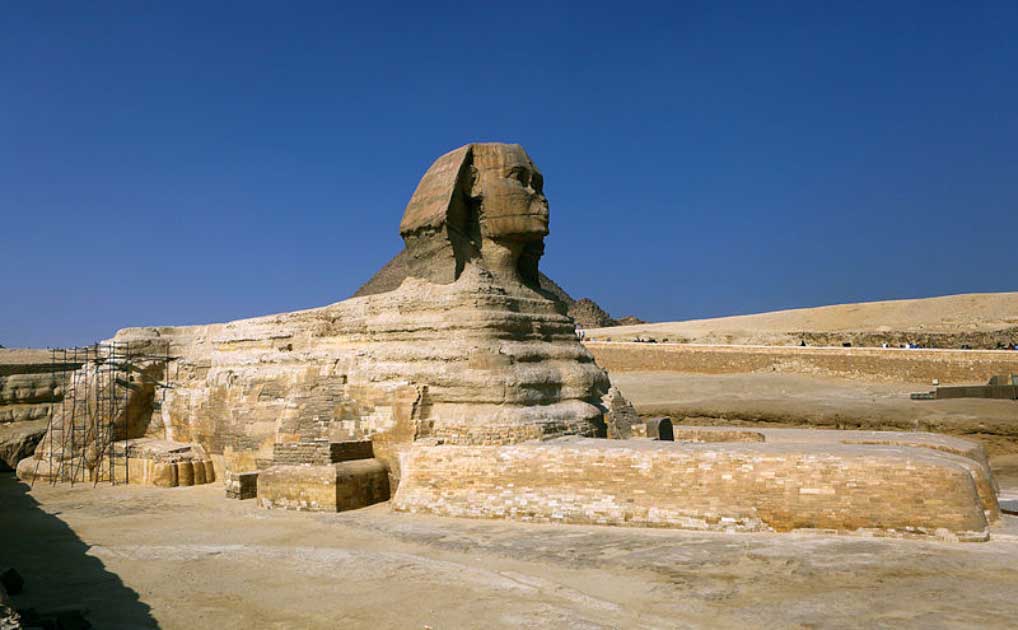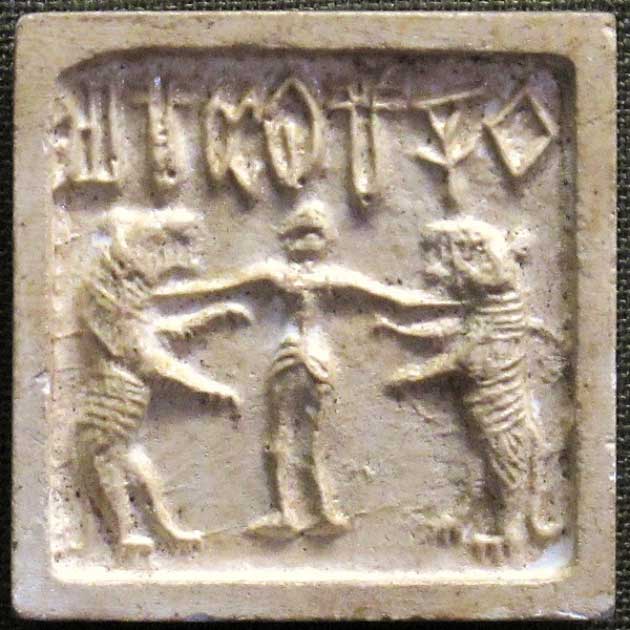One of the most famous of the many magnificent structures built in Ancient Egypt is the Great Sphinx of Giza. The Sphinx was carved out of a giant block of limestone and depicts a reclining mythological sphinx with the body of a lion and the face of a human.
The Great Sphinx of Giza is one of the most recognizable statues in the world and is on most people’s Egyptian bucket lists. However another sphinx may have been uncovered in Pakistan along the Makran Coastal Highway.
While scientists and journalists almost all agree that the Sphinx of Balochistan is nothing more than a rock structure shaped by time and natural elements, others believe that the rocks are a sphinx that guards the remains of a Hindu temple that the scientific and historical world is completely ignoring.
The Balochistan Sphinx
The Balochistan Sphinx, also referred to as the “Lion of Balochistan,” is a large rock structure that looks very similar to the Great Sphinx of Giza. The Balochistan Sphinx is located in the Hingol National Park, along the Makran Coastal Highway, which connects Karachi to Gwadar in Pakistan.
Hingol National Park is known for its unique rock formations, which became a popular tourist attraction not long after the completion of the Makran Coastal Highway. A prominent theory about the Balochistan Sphinx is that it is not a fantastic example of erosion but a man-made structure.
For those who believe the Balochistan Sphinx is not a natural rock formation, several details about the structure itself support the man-made theories. The Balochistan Sphinx’s most notable detail is pretty much that it looks like an Egyptian Sphinx.

In photos, the Balochistan Sphinx appears to have a chiseled and well-defined jawline and facial features, including eyes, a nose, and a mouth. Much like Egypt’s sphinx, the Balochistan Sphinx looks like it is wearing a headdress too.
A Nemes Egyptian pharaoh head-dress that the Great Sphinx wears on its head. A Nemes head-dress is a striped head cloth covering the back of the head, neck, and crown of the head. Two flaps on the side hang under the ears, in front of both shoulders. The Nemes is held in place with a headband, and the Balochistan Sphinx has a horizontal groove “across the forehead which corresponds to the pharaonic head-band that holds the Nemes in place.”
The Balochistan Sphinx also has identifiable forelegs in a reclining position and “very well-defined paws.” These details are hard to blame on nature alone; for many there is no other explanation except that human hands must have been involved.
There is more to the site of the Balochistan Sphinx than meets the eye. Bibhu Dev Misra, a history of ancient civilizations writer who has written extensively on the Balochistan Sphinx, points out that located near the sphinx is a structure that looks like a Hindu Temple with features of temples found in Southern India.
Misra points out that this structure has a Mandapa (entrance hall) and a Vima (temple spire). However, the top of the Vimana is missing. Misra writes, “a closer look at the Sphinx-Temple shows clear evidence of rock-cut pillars carved on the walls of the temple. …above the entrance, one can make out the contours of a sculpted persona. Overall, there can be little doubt that this is a man-made, rock-cut, temple of immense age, which has been heavily eroded and covered with sediments.”
Misra suggests that the facade of the Balochistan Sphinx shows carved images of what appears to have once been the Hindu deity Kartikey with a spear. Next to that, the second sculpture is believed to be a walking Ganesha.
A feature of the Balochistan Sphinx temple complex is a series of stairs that are evenly spaced and of uniform height, something nature can not do. Looking at the Balochistan Sphinx, it does appear to be a weathered sphinx guarding what remains of a Hindu Temple. Nature blurred the lines, but men cut the stone. Right?
Issues With the Balochistan Sphinx
There are a lot of issues with the Balochistan Sphinx and the theory that it was man-made. One of the first issues, which Misra mentions in his writings, is that there has yet to be an archaeological survey conducted on the site.
If there were this sphinx and the remains of a temple, there would have been an archeological survey by now. There hasn’t been because there is nothing significant there. A second issue is that Bibhu Dev Misra is the only person to produce writings about the Balochistan Sphinx, which is a big hit to credibility.
The next hit is that Misra is an information technology consultant and an “independent researcher.” There is nothing wrong with being an “independent researcher”, one wrote this very article. The problem is that Misra is his only source.
His articles appear on multiple conspiracy theory websites and in magazines like Science to Sage, Esamskriti, and New Dawn. Peer-reviewed publications with supporting primary sources are two necessary parts of researching history, and there is only one man’s writing. In addition, Misra has written in several articles that he, himself, has never been to see the sphinx.
In several articles, Misra even writes, “It is ridiculous to suggest that nature has carved out a statue which resembles a well-known mythical animal to such an extraordinarily high degree.” While the Balochistan Sphinx seems sphinx-like, what is occurring is a psychological phenomenon known as pareidolia.

Pareidolia is the tendency for perception to impose a meaningful interpretation on a nebulous stimulus, usually visual, so that one sees an object, pattern, or meaning where there is none. Some examples of pareidolia are seeing faces or animal shapes in clouds, seeing a happy face on an outlet, or Elvis on a piece of burnt toast. It is a normal phenomenon, and it leads to suggestive thinking.
Tourists have called the rock structure Balochistan Sphinx for many years. When you visit something with “sphinx” in its name, you expect it to look like a sphinx. That is what is occurring here.
Suppose this natural rock structure was called The Balochistan Thumb. Would you see it and think, “nope, that’s an Egyptian sphinx in Pakistan.”? Misra mentions the entire temple is covered in sediment that has eroded the structure. If sediment eroded the structure, why is it absurd to suggest the whole site is shaped due to sediment erosion?
The Makran Coast of Balochistan is known for its significant seismic activity. These earthquakes produce gigantic tsunamis. An earthquake off the coast of Makran in 1945 triggered a tsunami with waves that reached as high as 13m (4ft).
In addition to the ground shifting, massive and incredibly fast water surges, the area has mud volcanoes. The mud volcanoes erupt and spew a relatively large amount of mud which, like lava, flows down its sides. Scientists have known for a long time how powerful the forces of erosion are. Look at the Grand Canyon in the United States, for example. Misra suggests that near the Balochistan Sphinx is a structure that appears to be a Hindu Temple, similar to those found in South Asia. This is problematic because the Balochistan Sphinx is in Pakistan; why would an ancient southern Hindu temple be built in Pakistan?
The site is located in what was once the Indus Valley; the Indus Valley Civilization (Harappans) and the following civilization, the Vedic Civilization, have been extensively studied, and at no point in the region over 9,000 years of existence did a southern India empire or kingdom rule the Indus Valley.
The Harappan culture is more closely related to that of the Mesopotamians in Iraq than the Dravidian culture found in Southern Asia. Along that line of discussion, the claims that there are carvings that look like Kartikeya and a striding Ganesha are potentially another example of Misra’s pareidolia twisting things around.

Kartikeya, Ganesha, Shiva, and other Hindu deities were not worshiped in the Indus Valley Civilization, which was active from ~3000 BC – 1900 BC. After the Indus Valley Civilization came the Indus Vedic Civilization which did not worship those deities. This is confusing since the Indus Vedic religion produced the Rig Veda, one of the canonical four sacred Hindu texts of the Veda.
There is a significant difference between Pakistani Hinduism, which came from the Vedic religion, and Indian Hinduism. The Rig Veda describes the Indus Vedic people eating beef, worshiping no idols, burying the dead, and there was no caste system.
Caste “varna” was a term forbidden in the Vedas as a form of idolatry. The Indus Vedic gods in the Vedas are different from the more prominently known “modern Hindu gods”, they are incredibly similar to Avestan Zoroastrianism deities.
If the Balochistan Sphinx were part of a Southern Asia-Esque Hindu temple, it would be much younger than what we see in Hingol National Park today. Misra cannot suggest who built the structure or when it was built because it is ancient.
Even when considering the effects of erosion, the structure would need to be almost prehistoric to have been man-made and worn down into what it is today. While the Balochistan Sphinx is interesting and can inspire creative thinking, when archeologists, geologists, and historians all say that the sphinx is a natural rock structure, trust the experts.
When the only information about the Balochistan Sphinx comes from one non-credible source, it is clear that there is nothing man-made about the structure.
Top Image: Some believe the Balochistan Sphix to be merely a curious mountain, while others are convinced it is an ancient temple. Source: Bilal Mirza / CC BY 2.0.